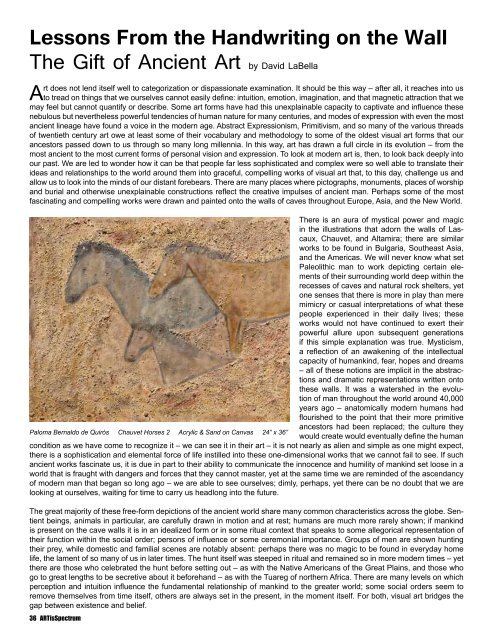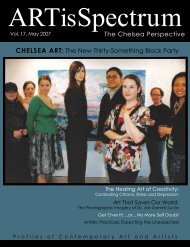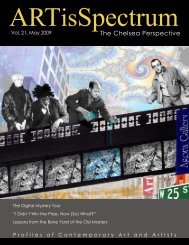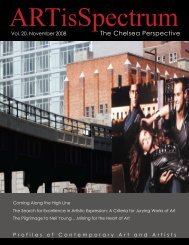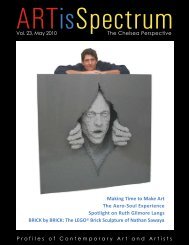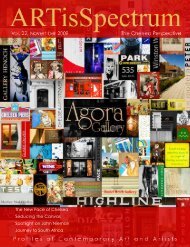Download PDF - ARTisSpectrum
Download PDF - ARTisSpectrum
Download PDF - ARTisSpectrum
- No tags were found...
You also want an ePaper? Increase the reach of your titles
YUMPU automatically turns print PDFs into web optimized ePapers that Google loves.
Lessons From the Handwriting on the WallThe Gift of Ancient Art by David LaBellaArt does not lend itself well to categorization or dispassionate examination. It should be this way – after all, it reaches into usto tread on things that we ourselves cannot easily define: intuition, emotion, imagination, and that magnetic attraction that wemay feel but cannot quantify or describe. Some art forms have had this unexplainable capacity to captivate and influence thesenebulous but nevertheless powerful tendencies of human nature for many centuries, and modes of expression with even the mostancient lineage have found a voice in the modern age. Abstract Expressionism, Primitivism, and so many of the various threadsof twentieth century art owe at least some of their vocabulary and methodology to some of the oldest visual art forms that ourancestors passed down to us through so many long millennia. In this way, art has drawn a full circle in its evolution – from themost ancient to the most current forms of personal vision and expression. To look at modern art is, then, to look back deeply intoour past. We are led to wonder how it can be that people far less sophisticated and complex were so well able to translate theirideas and relationships to the world around them into graceful, compelling works of visual art that, to this day, challenge us andallow us to look into the minds of our distant forebears. There are many places where pictographs, monuments, places of worshipand burial and otherwise unexplainable constructions reflect the creative impulses of ancient man. Perhaps some of the mostfascinating and compelling works were drawn and painted onto the walls of caves throughout Europe, Asia, and the New World.Paloma Bernaldo de Quirós Chauvet Horses 2 Acrylic & Sand on Canvas 24” x 36”There is an aura of mystical power and magicin the illustrations that adorn the walls of Lascaux,Chauvet, and Altamira; there are similarworks to be found in Bulgaria, Southeast Asia,and the Americas. We will never know what setPaleolithic man to work depicting certain elementsof their surrounding world deep within therecesses of caves and natural rock shelters, yetone senses that there is more in play than meremimicry or casual interpretations of what thesepeople experienced in their daily lives; theseworks would not have continued to exert theirpowerful allure upon subsequent generationsif this simple explanation was true. Mysticism,a reflection of an awakening of the intellectualcapacity of humankind, fear, hopes and dreams– all of these notions are implicit in the abstractionsand dramatic representations written ontothese walls. It was a watershed in the evolutionof man throughout the world around 40,000years ago – anatomically modern humans hadflourished to the point that their more primitiveancestors had been replaced; the culture theywould create would eventually define the humancondition as we have come to recognize it – we can see it in their art – it is not nearly as alien and simple as one might expect,there is a sophistication and elemental force of life instilled into these one-dimensional works that we cannot fail to see. If suchancient works fascinate us, it is due in part to their ability to communicate the innocence and humility of mankind set loose in aworld that is fraught with dangers and forces that they cannot master, yet at the same time we are reminded of the ascendancyof modern man that began so long ago – we are able to see ourselves; dimly, perhaps, yet there can be no doubt that we arelooking at ourselves, waiting for time to carry us headlong into the future.The great majority of these free-form depictions of the ancient world share many common characteristics across the globe. Sentientbeings, animals in particular, are carefully drawn in motion and at rest; humans are much more rarely shown; if mankindis present on the cave walls it is in an idealized form or in some ritual context that speaks to some allegorical representation oftheir function within the social order; persons of influence or some ceremonial importance. Groups of men are shown huntingtheir prey, while domestic and familial scenes are notably absent: perhaps there was no magic to be found in everyday homelife, the lament of so many of us in later times. The hunt itself was steeped in ritual and remained so in more modern times – yetthere are those who celebrated the hunt before setting out – as with the Native Americans of the Great Plains, and those whogo to great lengths to be secretive about it beforehand – as with the Tuareg of northern Africa. There are many levels on whichperception and intuition influence the fundamental relationship of mankind to the greater world; some social orders seem toremove themselves from time itself, others are always set in the present, in the moment itself. For both, visual art bridges thegap between existence and belief.36 <strong>ARTisSpectrum</strong>


